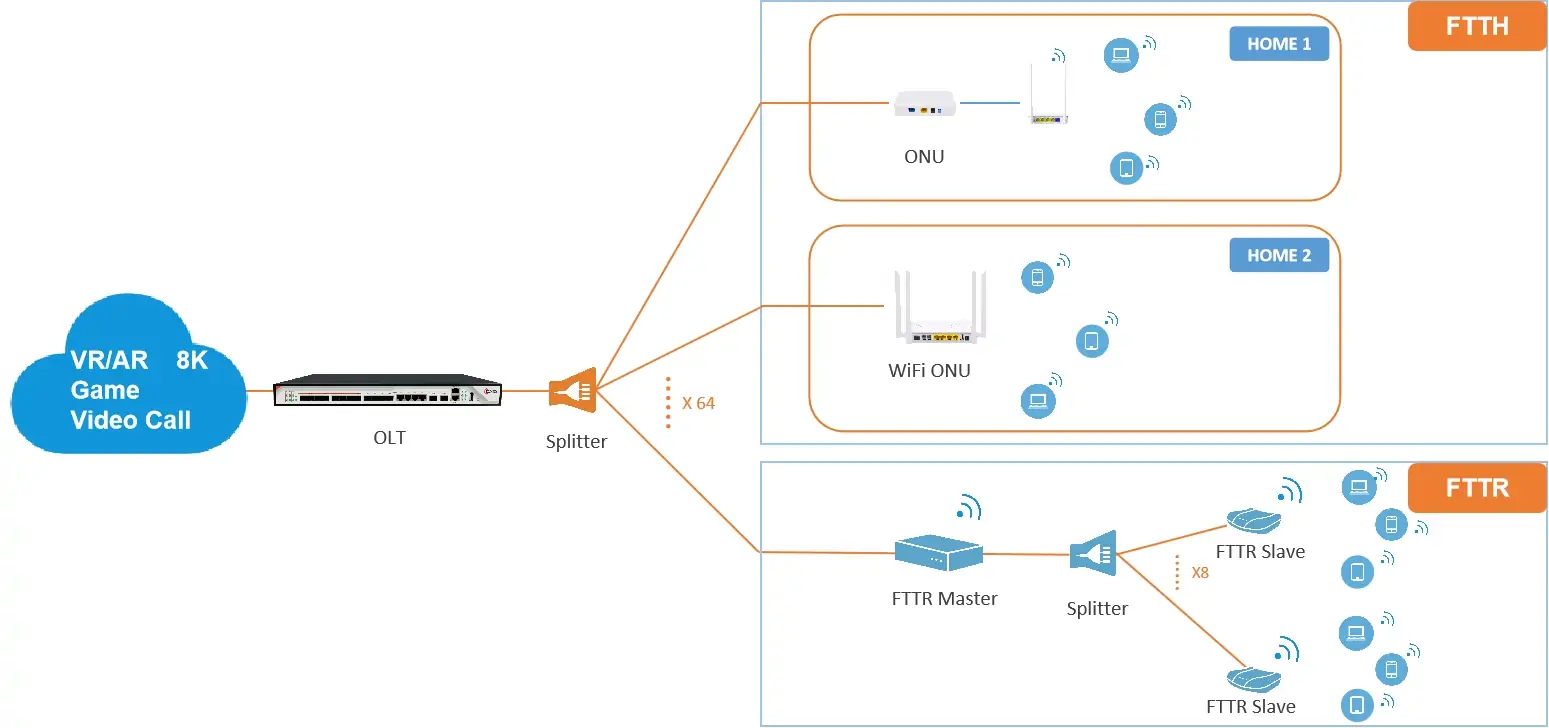In recent years, the communication industry has been continuously accelerating the upgrade of optical bandwidth. The continuous improvement of optical access and other network infrastructure has brought convenience to our life. At the same time, innovative business applications are also increasing, such as ultra-high definition video, cloud VR, cloud games, online education, etc. which put forward higher and higher requirements for network bandwidth, delay, jitter and so on.Therefore, FTTR has emerged on the basis of both Fiber-to-Building and Fiber-to-Home.
FTTH: Fiber To The Home, it is a transmission method of optical fiber communication. Specifically, FTTH refers to the installation of optical network unit (ONU) at home users or enterprise users.
FTTR: Fiber To The Room, it is a new kind of in-premises networking technology which is based on optical fibre communication.
At present, fiber to the home is usually completed by the operator’s fiber to the home, excluding the indoor network. Users need to arrange the indoor network by using wireless router, PLC, MOCA and other technologies according to their needs. FTTR is not only an optical fiber into the home, but also an optical fiber network covering all rooms can be established through FTTR equipment.
The application and requirements of FTTR are described in detail in ITU-T GSTP-FTTR document, among which the indoor high-quality WiFi networking requirements are ranked first.
WIFI technology has spread to a wide range of products including computers, PADs, smartphones, televisions and smart speakers. WIFI is an essential part of home networks, and people increasingly rely on WIFI connections to support their network connection needs. In FTTH mentioned earlier, after optical access, we can provide network access for all kinds of WIFI terminals by connecting to self-purchased home routers through the Ethernet port of ONU (insert single-port ONU link) or by integrating WIFI function into ONU with WIFI function.
Since the first version of WIFI standard IEEE 802.11a was released in 1997, WIFI technology has been developing and updating, and the transmission rate has been increasing. Currently, WIFI6 technology supports up to 9.6 Gbit/s. The higher rate WIFI7 (802.11be) standard is also under study.
| WiFi version | WiFi standards | Release time | Maximum rate | Operating frequency band |
| WiFi 6 | IEEE 802.11ax | 2019 | 11Gbps | 2.4GHz 或 5GHz |
| WiFi 5 | IEEE 802.11ac | 2014 | 1Gbps | 5GHz |
| WiFi 4 | IEEE 802.11n | 2009 | 600Mbps | 2.4GhHz 或 5GHz |
| WiFi 3 | IEEE 802.11g | 2003 | 54Mbps | 2.4GHz |
| WiFi 2 | IEEE 802.11b | 1999 | 11Mbps | 2.4GHz |
| WiFi 1 | IEEE 802.11a | 1999 | 54Mbps | 5GHz |
| WiFi 0 | IEEE 802.11 | 1997 | 2Mbps | 2.4GHz |
Because of the diversity of housing types and the attenuation of wireless signals by space and walls, it is difficult for a single router to cover the whole house with wireless WIFI signals, so the WIFI Alliance has introduced an EasyMesh solution.
In this solution, multiple Wi-Fi access points (AP) are formed as a local area network (LAN).
Indoor wireless networking for large-sized houses can be achieved by networking multiple wireless routers that support EasyMesh function. However, because Mesh routers are distributed in different rooms and 5GHz signal attenuation is large, the installation point of the router does not guarantee the quality of direct wireless connection between routers and gateways.
When you enjoy the home network services, such as video call,video conference,high-definition video (8k), augmented reality/virtual reality (AR/VR) or hologram in the future, you would like to sit or move freely without causing any inconveniences for service delay, loss connection, etc. So to form such a mesh network with high connection data rate & reliable roaming,FTTR, a fiber-based backhaul link with enough capacity is necessary compare with Wireless or UTP.
| FTTR | Ethernet(UTP) | Wireless | |
| Transmission Stability | High | High | Low |
| Bandwidth | High (speed upgrade independent to ODN) | High (speed upgrade dependent to UTP cable) | Medium |
| Range | Sufficient for home (To be defined) | <100m | Uncertain (depends on channel) |
| Manageable | Could be managed (To be defined) | No | No |
Compared with the traditional network technology and FTTH, FTTR (Fibre to The Room) all-optical Wi-Fi network solution allows users to achieve high-speed Internet experience at any time. It can directly extend the optical fiber to every room, and it is the only new technology in the industry that can realize the coverage of the whole house (not just one or two rooms) above Gigabit.

FTTH & FTTR Network
Network provides support for service. High-quality service also takes full advantage of the network. Service and network complement each other. FTTR is a further extension to home network based on FTTH. FTTR has been piloted, but it is still a long way from popularization. It can only develop gradually with the development and popularization of high-definition video, VR/AR, cloud games and other services.